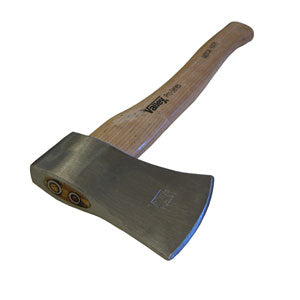It seems you're taking this a little personal. The avg person picking up an axe from the hardware store today vs the early 60s probably have vastly different expectations. I agree the others geometry heat treat play major roles. I don't care if people agree with me, I'm asking the controversial question. So cost and convenience are bigger concerns than trying to improve the quality, I guess companies using 3cr13 is proof. Maybe any difference is only theoretical, but id sure like to see 80 years of alloying recipes with a range of heat treats go head to head with the basic 1060. and chart the tradeoffs.
I'm not taking it personally whatsoever, it's just you're repeatedly ignoring what I'm saying as someone who has direct experience working in the industry. There's literally no controversy over it--it's very well established.
The historical steel grades were generally poorer than basic 1055-1080 is today. We have better consistency in the raw materials, and that allows us to now get more consistent heat treatment as a result. However, the biggest limiting factor in geometry is the drop forging process. You can hand-forge, open-die forge, or forge press a geometry to thinner dimensions than you can with drop forging, which means that you don't need as much finish grinding to achieve a good result, but that work is higher-skilled "work of risk" where there's a greater chance of screwing up and ruining a head due to one misplaced blow. In addition to it being difficult to find, hire, and retain workers capable of that kind of work at a price the mass market will bear, due to labor market changes over history, you do have a higher failure rate in finished product (historical makers sold their "second rate" heads at a discount to offload them), and more man-hours. Some small shops have had success returning to this model of production, but their products are MUCH more expensive than the ones from volume manufacturers and/or take advantage of exchange rates to bring cost down to something North American and Western European buyers of boutique axes can stomach.
Some historical manufacturers used alloy steels (mostly similar to 5160 etc.) rather than plain carbon steels, but most advertised things like "special analysis" steels and so on which just meant that they were making sure the raw material they received was consistently the proper grade without significant variation, which used to happen a lot, and impacted everything from the forging behaviors to heat treatment needed, and you can't dial in your production and heat treatment well without that consistency. Nevertheless there were countless axes made and broken historically that were the result of poor steel or heat treatment, often resulting from things like cold shuts/delamination in welded bits, inclusions, or the steel simply not being consistent batch to batch and resulting in the heat treatment protocol they used not producing the results they were shooting for. We tend to get a lot of survivor bias in old axes today because out of the ones that were used only the "good ones" made it.
Cost and convenience are bigger factors in why fancier steels aren't used, yes, but that's not necessarily out of "not wanting to improve the quality" so much as it just literally not conferring meaningful benefit vs. other factors that would have to be addressed
first before any measurable difference could be attributed to the steel choice, and even then it would be minimal. Like you don't need a V8 engine in a golf cart, you don't need fancy steel to make a high quality axe. There are many premium axes, not just in price, but in performance/design/labor that are made from plain steels. You can easily heat treat 1060 hard enough a file won't reliably bite it and have it hold up, but ironing out any edge damage from hitting a rock (which will damage any axe of any steel) is a challenge if you can't use a file in the field to get that head back to work, and have to grind it out instead.
Essentially, define the "better" qualities you want out of an axe, and most of them are going to boil down to things that need to change in the geometry and heat treatment more than the steel. If a steel that improves those qualities is more expensive and less convenient to purchase and turn into a finished product, it needs to be
meaningfully better than the easier cheaper thing. If the easier, cheaper thing works 99.99% as well as the less convenient, more expensive thing, it's simply not a good value proposition for the maker OR buyer.


